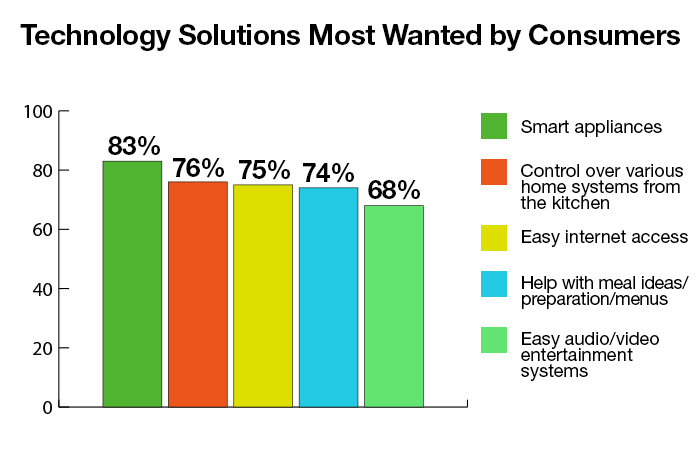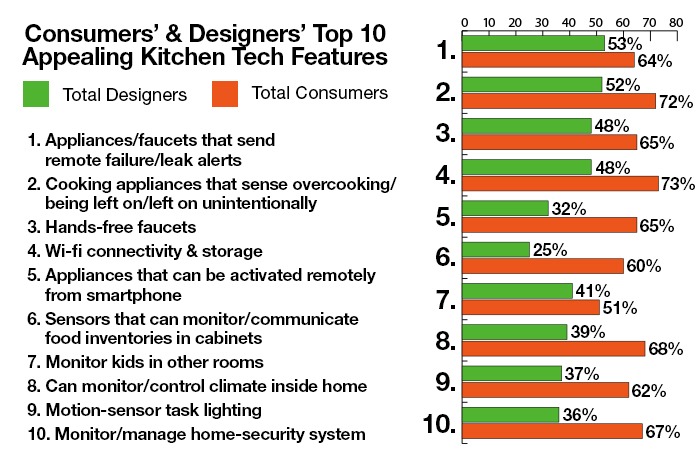Talking Tech in Today’s Kitchens

October 8, 2018
The National Kitchen & Bath Association (NKBA) recently released the results of its Kitchen Technology Awareness and Usage Report, the purpose of which is to prepare NKBA designers with what they need to fulfill their clients’ consumer technology needs. The survey’s timeliness is on par, as according to the International Data Corp.’s Worldwide Quarterly Smart Home Device Tracker, the worldwide smart home devices market is expected to grow 31 percent year over year in 2018 to 643.9 million shipments.
The NKBA survey polled 198 designers and 301 consumers and explores the reasons behind why consumers are not taking advantage of the technology available to them. In terms of designers, the survey found that they are interested in learning more about the following:
- Smart Appliances 74%
- Centralized lighting controls 66%
- Integrated mobile device charging/storage 58%
- Voice activation with kitchen devices 57%
- Motion-sensor task lighting 52%
- Automated faucets 51%
- Internet connectivity/storage 41%
- Whole-house controls/monitoring 37%
- Music/speaker connections 29%
- Built-in monitors for video/internet 29%
- Security monitoring 28%
So if there are designers out there who are still in the dark about certain types of technology, how are they going to create successful projects for homeowners who want to frequently – or even moderately – use it? What about those consumers who have mixed ideas about including technology in their projects?

Helping Your Clients Hit the Refresh Button
Instead of just learning about technology, designers need to help their clients overcome their misgivings about technology, which include its price point, how it will benefit them, security concerns (a big factor of which KBB learned in a Houzz poll we conducted in July), ease of use, reliability and compatibility with other devices. Designers need to immerse themselves with the technology solutions available in the market today, as the study found that only 1/3 of them are recommending these solutions because of a lack of knowledge.
The survey tells us that most consumers use general technology in their kitchens – emailing/texting, using Google and Pinterest to find recipes and creating online grocery lists. If those consumers also knew more about what was available to them, perhaps they would become frequent technology users who could benefit from adding value to the home, saving time, improving the home’s appearance and creating a more comfortable space. Other benefits of adding technology to the kitchen include increased safety, reduced clutter and improved cooking ability.

Why Technology Is Important to Today’s Homeowner
The survey found that consumers value technology because it makes their lives easier, but they do not want their kitchens to have a “techy” look and feel. Some of their attitudes and concerns could be addressed if today’s designer had more knowledge about installing technology, which would come with pairing up with a professional integrator. Those people can address such things as:
- How to integrate various systems in a home
- How to update technology as it changes
- How to control everything in the kitchen with a mobile device
- Voice control versus touch pad control
Just as being well versed in sustainable or universal design takes time and the probability of including additional team members, so does becoming an expert in smart design solutions. Becoming aware of what technological advancements are available to our industry is the first step, the second and equally important is including a professional integrator/installer to your team. Besides being simply impressed with your design prowess, they will learn what they need to include in their kitchens to make their lives easier, safer and more fun.
More News
April 19, 2024 | Business
Artistic Tile Paramus Unveils New Location
April 18, 2024 | Business, People
Excelling at Kitchen Design When You Don’t Like to Cook
April 18, 2024 | Awards & Events
KCMA Design Awards Announces Winners
April 17, 2024 | People
WAC Lighting Promotes Becky Li to President
April 16, 2024 | Awards & Events
Kips Bay Boys & Girls Club Honors Ellie Cullman, Cosentino
April 2, 2024 | Sponsored
Whirlpool Corp. Brings Purposeful Innovation Home